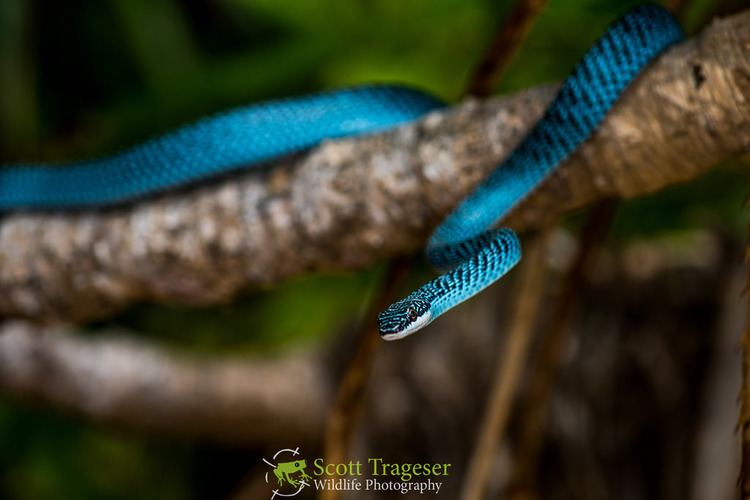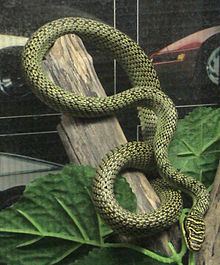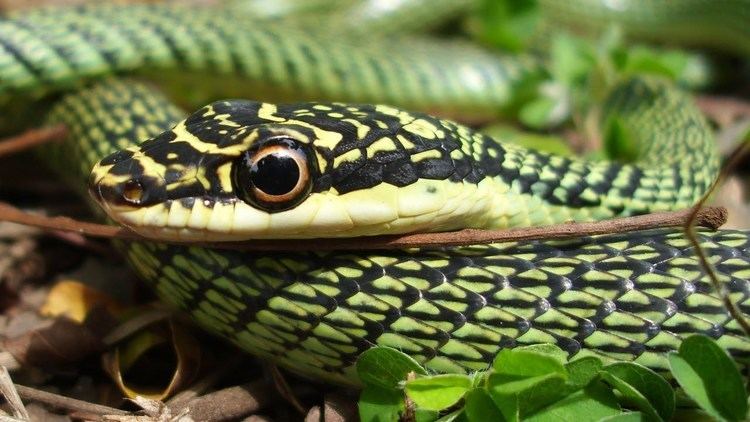Subphylum Vertebrata Suborder Serpentes Rank Species | ||
 | ||
Similar Snake, Flying tree snakes, Reptile, Chrysopelea paradisi, Ahaetulla prasina | ||
Golden tree snake flying snake schmuckbaumnatter chrysopelea ornata
Chrysopelea ornata is a colubrid snake found in both South and Southeast Asia. It is, along with the other species in its genus Chrysopelea, very unusual in that it is capable of a type of gliding flight. It is also rear-fanged. Currently, three subspecies are recognized. The snake's striking looks and capability of gliding make it a popular choice for captivity.
Contents
- Golden tree snake flying snake schmuckbaumnatter chrysopelea ornata
- Flying snake chrysopelea ornata
- Description
- Venom
- Common names
- Geographic range
- Conservation
- Subspecies
- Behaviour
- Flight
- Human habitats
- Reproduction
- In captivity
- References

Flying snake chrysopelea ornata
Description

Chrysopelea ornata is usually green in color, with black cross-hatching and yellow or gold colored accents. The body, though slender, is far less so than in other tree snakes. It has a flattened head with constricted neck, a blunt nose and large eyes with round pupils.

The lateral, sharp and pronounced keeled condition of the ventrals in association with the normal, not enlarged, vertebral row of scales distinguish this snake.

This snake ranges from 11.5 to 130 cm (0.38 to 4.27 ft) long. Maturity is reached at about 1 m (3.3 ft) in length. The tail is about one-fourth of the total length.
Chrysopelea ornata has two major colour forms, which are largely determined by geographic locality, and their descriptions are given below:
Venom
This species is considered mildly venomous, with no confirmed cases of medically significant envenomation. It is not considered dangerous to man.
Common names
Geographic range
India (North Bengal), Bangladesh, Sri Lanka, Myanmar, Thailand, Western Malaysia, Laos, Cambodia, Vietnam, China (Hong Kong, Hainan, Yunnan), Indonesia (Sumatra, Java, Borneo, Sulawesi), and the Philippines.
In India Chrysopelea ornata ranges from the Western Ghats, up to the Dangs, Katernia Ghat in Uttar Pradesh, North Bihar, northern West Bengal eastwards to Arunachal Pradesh. It is also found in the forests of the Andaman islands.
Conservation
Not known to be endangered.
Subspecies
There are three recognized subspecies of C. ornata:
Behaviour
Chrysopelea ornata is diurnal and arboreal. The snake's gliding ability, while not as impressive as that of the paradise flying snake (C. paradisi), still makes it capable of moving from tree to tree with relative ease. These snakes are excellent climbers, being able move across even the smallest of branches and even straight up trees with few branches by using the edges of rough bark. They are frequently seen moving up a coconut palm, or up vertical rock faces in graceful curves, gripping the somewhat uneven surfaces with their scales. They tend to be nervous, fast-moving snakes, and will attempt to flee if disturbed, but will not generally hesitate to bite if handled. They are mildly venomous, but the venom is not considered to be dangerous to humans. It is intended to assist in subduing fast moving, arboreal prey. C. ornata takes small arboreal prey, such as lizards, bats and small rodents. It might also feed on bird eggs and insects. Also it is reported to take snakes occasionally, and to avoid frogs, though frogs are also reported being eaten. The snake stalks or pursues the prey and seizes it by the neck, which is crushed in its strong jaws.
Flight
Chrysopelea ornata, like others of its genus, glides or parachutes. This is presumably done to cover distances faster, to escape predators, to catch prey, or to move around in forests. Flying snakes usually parachute from tree to tree, but sometimes launch themselves from trees onto the ground. They have been known to cross as much as 100m.
It does this by climbing up to a height, which it does easily by virtue of its keeled belly scales, and then launching itself into mid-air. The snake contracts its ventral surface inwards to form a U-shaped concave depression along the entire length of their bodies, holding the outer edges of the ventral scales rigid. This concave surface acts like a parachute, and increases air resistance, allowing the snake to glide forward with the thrust of its launch. The snake undulates through the air, in a swimming-like motion. It holds the tail rigidly upwards, and by twisting the tail from side to side, it attains balance. This motion allows it to propel forward, landing clumsily at the end of its flight.
Human habitats
Chrysopelea ornata is a common snake and has adapted well to human habitats. In southern parts of Thailand, they are reported to hide in the thatch of the roofing material inside bungalows to prey on geckos and mice during the night. In these areas, one can almost be certain to be relatively close to a C. ornata most anywhere, perhaps hiding in the crown of the nearby coconut palm, under the roots of a tree, or even curled up in a potted plant. When hunting and pursuing fleeing prey, they have been reported to drop down out of the crown of coconut palms. Snakes are often indiscriminately killed, as many locals incorrectly assume all snakes are venomous. C. ornata is sometimes cooked for food.
Reproduction
Breeding habits are little known. The snake is oviparous and six to twelve elongated eggs are laid. Gravid females have been obtained in May and June and hatchlings in June. In Bangkok, according to Smith, mating takes place in June. Hatchlings measure 114–152 mm (4 1⁄2 to 6 in) long, while the smallest gravid female recorded was 1,093 mm (3 ft 7 in) long.
In captivity
In recent years, ornate flying snakes have become increasingly available in the exotic pet trade; many are exported from Vietnam and neighboring countries. Instances of captive breeding are virtually unknown. Due to the species' nervous temperament and difficulty to adjusting to captivity, they tend to make poor captives for all but the most experienced reptile keepers. Many imported specimens have heavy parasite loads, and the stress of captivity all too often leads to a quick death.
